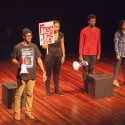Professor to perform all 32 Beethoven piano sonatas
Rare is the pianist who accepts the challenge of learning all 32 piano sonatas by Beethoven. Rarer still is the keyboard virtuoso who decides to perform all of them in public, from memory, over the course of little more than two months. But that is what Christopher Taylor has planned to keep himself occupied this spring.
Taylor, an associate professor of piano at the University of Wisconsin–Madison, is no stranger to musical projects that most pianists would find daunting. During the last few years, he has performed Olivier Messiaen’s "Vingt Regards sur l’Enfant-Jésus," which New York Times critic Anthony Tommasini called "more than two hours of some of the most complex and difficult music ever written for the piano."
He then tackled all 28 etudes by the late Hungarian composer Gyorgy Ligeti, a "Herculean undertaking" that at times led to "an edgy feeling of danger" according to Joshua Kosman, writing about Taylor’s performance for the San Francisco Chronicle.
But amidst this affinity for cutting-edge idioms, how does the choice of a complete Beethoven sonata cycle, clocking in at about 11 hours of music, fit in? Taylor, who will present these concerts on the UW–Madison campus beginning on Wednesday, Feb. 13, says it’s the culmination of a 30-year project.
As an 8-year-old, Taylor made it very clear to his piano teacher that he wanted to play Beethoven. Although his teacher resisted acquiescing for a time, she relented before his ninth birthday, introducing him to Opus 10, No. 1. Since then, Taylor says that despite playing the works of dozens of other composers, "Beethoven remains the focal point of my musical life," with a goal of mastering all 32 sonatas never far from his sights. His first sabbatical from teaching at UW–Madison gave him the perfect opportunity to realize this goal.
Taylor decided fairly early in his planning on a 10-concert series — other pianists have played fewer but longer programs — and chose to group them not in chronological order but according to other guiding principles. "I found that the more massive sonatas formed nuclei around which programs naturally grew," he says. Adding chronological diversity, recurring thematic motives and key relationships to the mix helped Taylor reach the final distribution.
He begins the first program on Feb. 13 with Opus 2, No. 1, Beethoven’s first, and concludes the 10th program on Friday, April 18, with Opus 111, the composer’s last. Taylor says he has performed most of the sonatas previously; only a few will have their "maiden voyage" in the series including, perhaps remarkably, the well-known "Moonlight" sonata, Opus 27, No. 2, which he last attempted in 1977 and has never performed publicly.
When asked what insights into Beethoven’s writing he hopes to share with the audience, Taylor says, "the tremendous variety in his piano writing in particular is what is so striking." Among the stylistic traits he cites are the heroic, humorous and pastoral. From the first sonata, Beethoven was pushing the limits of the technical possibilities of the instrument, Taylor says, and as piano makers added new keys, he started using those notes. His piano sonatas provide a good illustration of Beethoven in the laboratory; ideas he tried there later showed up in his symphonies.
Taylor doesn’t let the grass grow under his feet even while preparing to perform 32 Beethoven sonatas. In the last week of January alone, his musical itinerary was immense. He performed the Messiaen "Vingt regards" for Cal Performances at the University of California, Berkeley, on Jan. 27 and participated in a public conversation with mathematicians David Benson and Robert Osserman the day before for Berkeley’s Mathematical Sciences Research Institute. By Jan. 31, he was seated at the double-manual Steinway piano owned by the UW–Madison School of Music for a concert of Bach’s "Goldberg" Variations at the Krannert Center at the University of Illinois. And on Thursday, March 27, he returns to Columbia University’s Miller Theatre for the world premiere of a concerto for piano and chamber orchestra by Japanese composer Ichizo Okashiro. That performance will fall between the seventh and eighth concerts of Beethoven sonatas in Madison.
All of Taylor’s concerts will be held in Mills Hall at the Mosse Humanities Building, 455 N. Park St.
General admission tickets are $12, $9 for seniors (age 60 and up) and students. UW–Madison students are admitted free with a valid ID. Tickets must show exact dates. A 10-concert subscription is available at $96 general, $72 seniors and students. For information, call or visit the Wisconsin Union Theater Box Office, located in a booth just outside the Park Street entrance to the Memorial Union, (608) 262-2201.
Tags: arts, events, School of Music

